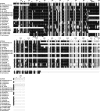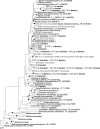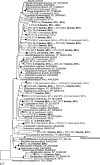Functional gene analysis suggests different acetogen populations in the bovine rumen and tammar wallaby forestomach
- PMID: 20889794
- PMCID: PMC2988603
- DOI: 10.1128/AEM.01679-10
Functional gene analysis suggests different acetogen populations in the bovine rumen and tammar wallaby forestomach
Abstract
Reductive acetogenesis via the acetyl coenzyme A (acetyl-CoA) pathway is an alternative hydrogen sink to methanogenesis in the rumen. Functional gene-based analysis is the ideal approach for investigating organisms capable of this metabolism (acetogens). However, existing tools targeting the formyltetrahydrofolate synthetase gene (fhs) are compromised by lack of specificity due to the involvement of formyltetrahydrofolate synthetase (FTHFS) in other pathways. Acetyl-CoA synthase (ACS) is unique to the acetyl-CoA pathway and, in the present study, acetyl-CoA synthase genes (acsB) were recovered from a range of acetogens to facilitate the design of acsB-specific PCR primers. fhs and acsB libraries were used to examine acetogen diversity in the bovine rumen and forestomach of the tammar wallaby (Macropus eugenii), a native Australian marsupial demonstrating foregut fermentation analogous to rumen fermentation but resulting in lower methane emissions. Novel, deduced amino acid sequences of acsB and fhs affiliated with the Lachnospiraceae in both ecosystems and the Ruminococcaeae/Blautia group in the rumen. FTHFS sequences that probably originated from nonacetogens were identified by low "homoacetogen similarity" scores based on analysis of FTHFS residues, and comprised a large proportion of FTHFS sequences from the tammar wallaby forestomach. A diversity of FTHFS and ACS sequences in both ecosystems clustered between the Lachnospiraceae and Clostridiaceae acetogens but without close sequences from cultured isolates. These sequences probably originated from novel acetogens. The community structures of the acsB and fhs libraries from the rumen and the tammar wallaby forestomach were different (LIBSHUFF, P < 0.001), and these differences may have significance for overall hydrogenotrophy in both ecosystems.
Figures





References
-
- Altschul, S. F., W. Gish, W. Miller, E. W. Myers, and D. J. Lipman. 1990. Basic local alignment search tool. J. Mol. Biol. 215:403-410. - PubMed
-
- Attwood, G., and C. S. McSweeney. 2008. Methanogen genomics to discover targets for methane mitigation technologies and options for alternative H2 utilisation in the rumen. Aust. J. Exp. Agric. 48:28-37.
-
- Balch, W. E., S. Schoberth, R. Tanner, and R. S. Wolfe. 1977. Acetobacterium, a new genus of hydrogen-oxidizing, carbon dioxide-reducing, anaerobic bacteria. Int. J. Syst. Bacteriol. 27:355-361.
-
- Bernalier, A., A. Willems, M. Leclerc, V. Rochet, and M. D. Collins. 1996. Ruminococcus hydrogenotrophicus sp. nov., a new H2/CO2-utilizing acetogenic bacterium isolated from human feces. Arch. Microbiol. 166:176-183. - PubMed
-
- Breznak, J., J. Switzer, and H. Seitz. 1988. Sporomusa termitida sp. nov., an H2/CO2-utilizing acetogen isolated from termites. Arch. Microbiol. 150:282-288.
Publication types
MeSH terms
Substances
Associated data
- Actions
- Actions
- Actions
- Actions
- Actions
- Actions
- Actions
- Actions
- Actions
- Actions
- Actions
- Actions
- Actions
- Actions
- Actions
- Actions
- Actions
- Actions
- Actions
- Actions
- Actions
- Actions
- Actions
- Actions
- Actions
- Actions
- Actions
- Actions
- Actions
- Actions
- Actions
- Actions
- Actions
- Actions
- Actions
- Actions
- Actions
- Actions
- Actions
- Actions
- Actions
- Actions
- Actions
- Actions
- Actions
- Actions
- Actions
- Actions
- Actions
- Actions
- Actions
- Actions
- Actions
- Actions
- Actions
- Actions
- Actions
- Actions
- Actions
- Actions
- Actions
- Actions
- Actions
- Actions
- Actions
- Actions
- Actions
- Actions
- Actions
- Actions
- Actions
- Actions
- Actions
- Actions
- Actions
- Actions
- Actions
- Actions
- Actions
- Actions
- Actions
- Actions
- Actions
- Actions
- Actions
- Actions
- Actions
- Actions
- Actions
- Actions
- Actions
- Actions
- Actions
- Actions
- Actions
- Actions
- Actions
- Actions
- Actions
- Actions
- Actions
- Actions
- Actions
- Actions
- Actions
- Actions
- Actions
- Actions
- Actions
- Actions
- Actions
- Actions
- Actions
- Actions
- Actions
- Actions
- Actions
- Actions
- Actions
- Actions
- Actions
- Actions
- Actions
- Actions
- Actions
- Actions
- Actions
- Actions
- Actions
- Actions
- Actions
- Actions
- Actions
- Actions
- Actions
- Actions
- Actions
- Actions
- Actions
- Actions
- Actions
- Actions
- Actions
- Actions
- Actions
- Actions
- Actions
- Actions
- Actions
- Actions
- Actions
- Actions
- Actions
- Actions
- Actions
- Actions
- Actions
- Actions
- Actions
- Actions
- Actions
- Actions
- Actions
- Actions
- Actions
- Actions
- Actions
- Actions
- Actions
- Actions
- Actions
- Actions
- Actions
- Actions
- Actions
- Actions
- Actions
- Actions
- Actions
- Actions
- Actions
- Actions
- Actions
- Actions
- Actions
- Actions
- Actions
- Actions
- Actions
- Actions
- Actions
- Actions
- Actions
- Actions
- Actions
- Actions
- Actions
- Actions
- Actions
- Actions
- Actions
- Actions
- Actions
- Actions
- Actions
- Actions
- Actions
- Actions
- Actions
- Actions
- Actions
- Actions
- Actions
- Actions
- Actions
- Actions
- Actions
- Actions
- Actions
- Actions
- Actions
- Actions
- Actions
- Actions
- Actions
- Actions
- Actions
- Actions
- Actions
- Actions
- Actions
- Actions
- Actions
- Actions
- Actions
- Actions
- Actions
- Actions
- Actions
- Actions
- Actions
- Actions
- Actions
- Actions
- Actions
- Actions
- Actions
- Actions
- Actions
- Actions
- Actions
- Actions
- Actions
- Actions
- Actions
- Actions
- Actions
- Actions
- Actions
- Actions
- Actions
- Actions
- Actions
- Actions
- Actions
- Actions
- Actions
- Actions
- Actions
LinkOut - more resources
Full Text Sources
Other Literature Sources
Molecular Biology Databases

